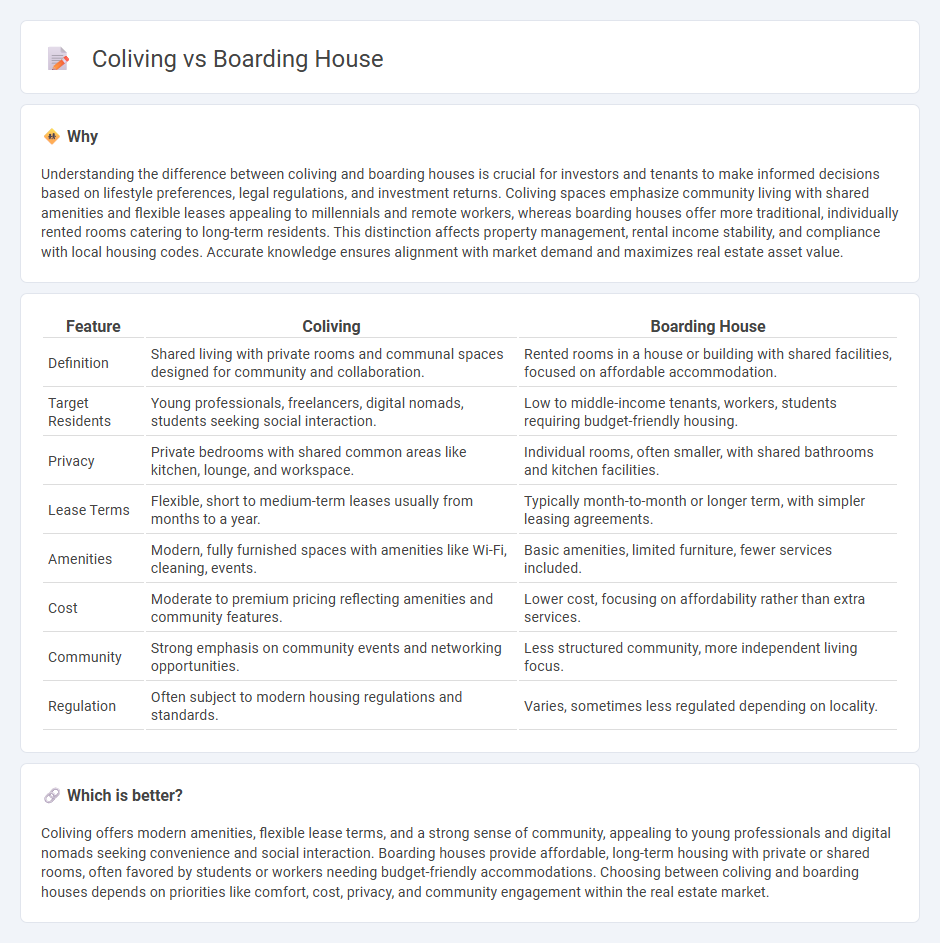
Coliving spaces offer modern, community-focused living with shared amenities and flexible leases, appealing to young professionals and digital nomads. Boarding houses provide more traditional, affordable accommodations with private rooms and communal facilities, often favored by long-term residents or students. Discover the key differences and benefits of coliving and boarding houses to find the best housing solution for your needs.
Why it is important
Understanding the difference between coliving and boarding houses is crucial for investors and tenants to make informed decisions based on lifestyle preferences, legal regulations, and investment returns. Coliving spaces emphasize community living with shared amenities and flexible leases appealing to millennials and remote workers, whereas boarding houses offer more traditional, individually rented rooms catering to long-term residents. This distinction affects property management, rental income stability, and compliance with local housing codes. Accurate knowledge ensures alignment with market demand and maximizes real estate asset value.
Comparison Table
| Feature | Coliving | Boarding House |
|---|---|---|
| Definition | Shared living with private rooms and communal spaces designed for community and collaboration. | Rented rooms in a house or building with shared facilities, focused on affordable accommodation. |
| Target Residents | Young professionals, freelancers, digital nomads, students seeking social interaction. | Low to middle-income tenants, workers, students requiring budget-friendly housing. |
| Privacy | Private bedrooms with shared common areas like kitchen, lounge, and workspace. | Individual rooms, often smaller, with shared bathrooms and kitchen facilities. |
| Lease Terms | Flexible, short to medium-term leases usually from months to a year. | Typically month-to-month or longer term, with simpler leasing agreements. |
| Amenities | Modern, fully furnished spaces with amenities like Wi-Fi, cleaning, events. | Basic amenities, limited furniture, fewer services included. |
| Cost | Moderate to premium pricing reflecting amenities and community features. | Lower cost, focusing on affordability rather than extra services. |
| Community | Strong emphasis on community events and networking opportunities. | Less structured community, more independent living focus. |
| Regulation | Often subject to modern housing regulations and standards. | Varies, sometimes less regulated depending on locality. |
Which is better?
Coliving offers modern amenities, flexible lease terms, and a strong sense of community, appealing to young professionals and digital nomads seeking convenience and social interaction. Boarding houses provide affordable, long-term housing with private or shared rooms, often favored by students or workers needing budget-friendly accommodations. Choosing between coliving and boarding houses depends on priorities like comfort, cost, privacy, and community engagement within the real estate market.
Connection
Coliving and boarding houses both offer shared living arrangements that maximize affordability and community engagement in real estate markets. These housing models address urban housing shortages by optimizing space utilization and providing flexible lease terms appealing to millennials and remote workers. Their shared amenities and social environments create attractive alternatives to traditional rental properties.
Key Terms
Lease Agreement
Boarding house agreements typically involve short-term leases with flexible terms, catering to transient residents and often including utilities and furnishings in rent. Coliving leases are usually longer, ranging from six months to a year, emphasizing community living with shared amenities and clear agreements on individual and common space usage. Explore more about how lease terms affect your choice between boarding houses and coliving options.
Shared Amenities
Boarding houses typically offer private rooms with shared basic amenities such as kitchens and bathrooms, emphasizing affordability and convenience for long-term residents. Coliving spaces provide a curated lifestyle experience with modern shared amenities like coworking areas, wellness facilities, and community events aimed at fostering social connections and productivity. Explore the unique shared amenities in each option to determine which best suits your living preferences and lifestyle needs.
Occupancy Regulations
Boarding houses often fall under strict local zoning and occupancy regulations, limiting the number of residents per room and requiring specific safety measures. Coliving spaces typically navigate more flexible regulatory frameworks aimed at fostering communal living while complying with residential building codes. Explore how these differences impact the operation and design of shared living environments.
Source and External Links
Boarding house - A boarding house is a residence, often a family home, where lodgers rent rooms typically on a nightly or extended basis, with common areas maintained and meals sometimes provided, offering room and board arrangements.
What is a Rooming House? - A rooming house (or boarding house) is a dwelling where individuals rent single rooms, often sharing kitchen and bathroom facilities, with at least four unrelated renters living there.
What Is A Boarding House? - CountyOffice.org - Boarding houses provide affordable lodging options with communal living spaces and meals, catering to diverse needs such as students, workers, or travelers in a shared housing environment.
 dowidth.com
dowidth.com